8.2 Language
In everyday speaking, a “language” is a system of communication used by people from a specific region or culture. Mandarin, Hindi, Spanish, and English, for example, are languages—
What Do We Mean by “Language”?
Preview Question
Question
 Do dogs use language?
Do dogs use language?
In psychology, however, the word “language” usually does not refer to a specific language, but to language in general: the ability to communicate using the words and rules of a language. Language is a communication system in which sounds, or non-
Language is not the only way that organisms communicate. Bacteria communicate by sending chemical signals (Pai & You, 2009). Animals communicate about their personal territory by leaving scents; that’s what your dog is doing when stopping at every tree in the neighborhood. However, these are not examples of language, which has two properties that distinguish it from these other forms of communication:
Arbitrary relation between words and things: The relation between the sounds of words and the objects to which they refer is often arbitrary (Brown, 1958). Consider “cat” and “dog.” The words don’t sound like the sounds made by cats and dogs. In print, they don’t look anything like a cat or dog. Yet they refer to these animals.
The exception to this arbitrariness is onomatopoeia: when words sound like the concepts they’re meant to convey, such as “giggle” and “hiccup.”
Generativity: A language’s rules are generative, which means that they can be used to produce (or “generate”) an infinite number of sentences—
including sentences that no one has ever uttered before. For example, not only is “The big dog chased the cat” a sentence, but so are “The big dog chased the cat who had chased the mouse,” “The big dog chased the cat who had chased the mouse that had eaten the cheese,” “The big dog chased the cat who had chased the mouse that had eaten the cheese that belonged to a man,” “The big dog chased the cat who had chased the mouse who had eaten the cheese that belonged to a man who owned a small dog that chased another cat who chased another mouse that had eaten cheese owned by another man,” and so forth. The list of potential sentences is endless.

Now let’s see how this unique mechanism of communication, language, is organized.
WHAT DO YOU KNOW?…
Question 5
The idioglossia between the isolated twins, described in the chapter opening, is an example of language because of the arbitrariness of the relation between the of the words and objects to which they refer and because they could use the words to generate sentences that no one had ever heard before, a concept called .
The Structure of Language
Preview Questions
Question
 How is language organized?
How is language organized?
Question
 What do the rules of syntax do?
What do the rules of syntax do?
Language is highly structured. You can’t make any sounds you want and expect to be understood. You must follow language’s rules—
LEVELS OF ORGANIZATION. Suppose you want to talk about your experiences in psychology (Figure 8.2). At the highest level of organization of language, you’re engaged in a conversation. Conversations have rules (Grice, 1975). If a friend says, “I have been feeling really depressed lately,” and you reply, “Don’t you love my new hat!” then you are violating a rule—
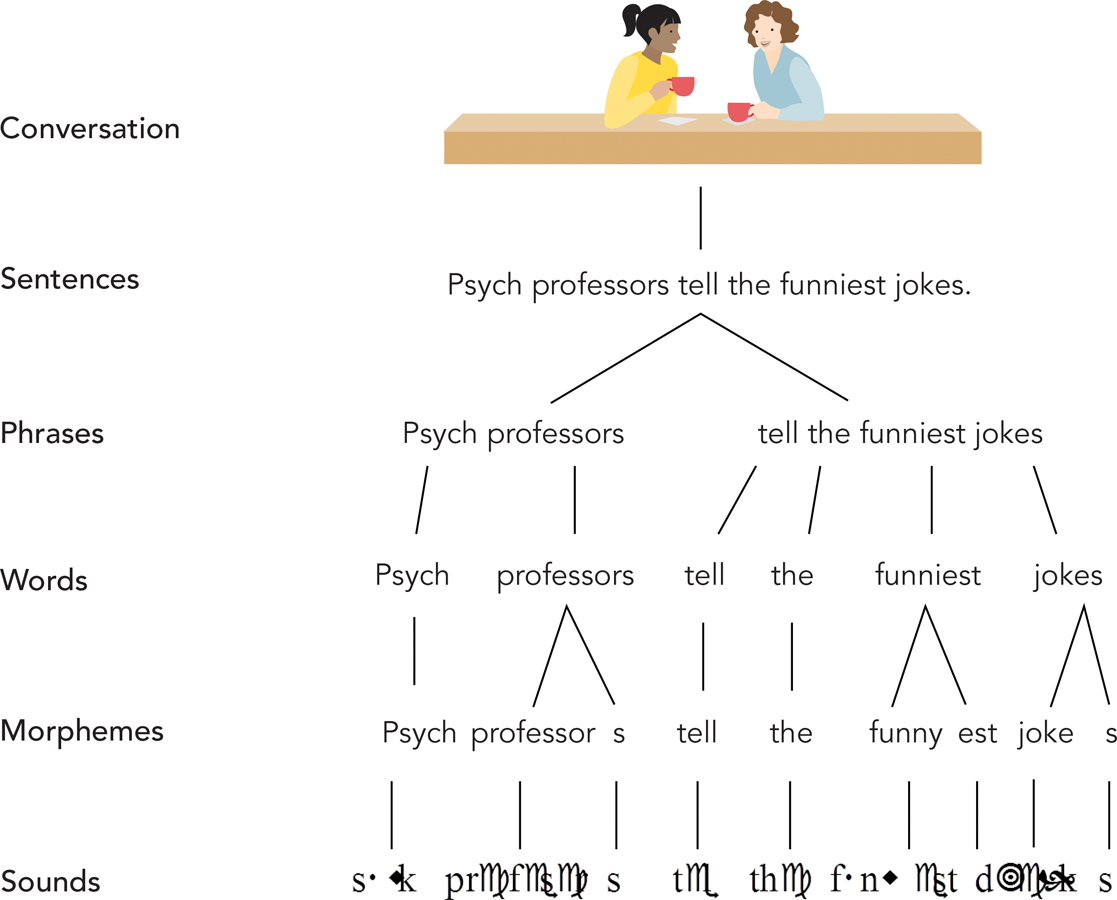
Conversations are structured by different points of view, or conversational “positions,” that people adopt (Harré & van Langenhove, 1999). At one moment, you may provide information to someone. A moment later, you may ask a question; your position shifts from “information provider” to “question asker.” Different positions bring different obligations, such as to provide information or to listen carefully.
In any conversation, the meaning of statements depends on the setting in which they occur (Austin, 1962). Suppose, at a dinner table, you say, “Salt.” Its meaning depends on the setting. It could be a command (to pass the salt), comment (that the food’s too salty), or answer (if someone has asked what you just added to your food).
Moving down one level (Figure 8.2), language is organized into sentences. Sentences bring remarkable power. With them, you can communicate about not only your immediate environment, but also those millions of miles (“It must be cold on Pluto”) and billions of years away (“The Big Bang must have been really loud”). Sentences can even refer to things that never existed (“When conversing, how do unicorns avoid poking each other’s eyes out?”).
At the next level down are the main parts of sentences, which are phrases. The syntax of a language is the set of rules that determine whether a particular series of phrases forms a sentence that is grammatically correct. Some arrangements of phrases are correct (“Psych professors tell the funniest jokes,” “Psych professors wonder why people differ”), whereas others are not (“Psych professors wonder the funniest jokes”). We discuss syntax in detail below.
One more level down, phrases are made up of words. Individual words can convey meaning by themselves: “No,” “Eureka.”
Moving down another level, words contain parts that convey meaning. “Funniest,” for example, contains two parts: “funny” plus “est,” which conveys extremity. “Unhappiest” contains three parts: the emotion (happy), extremity (“est”), and a reversal of the emotional state (“un”). These parts are morphemes. A morpheme is the smallest part of a language that conveys meaning. Morphemes can be as small as a single letter—
Finally, at the lowest level of analysis, language consists of sounds. Phonemes are the smallest units of sound that convey meaning in a language. Here, too, language is organized; some sounds patterns are common in a language, whereas others are not. Different languages use different sounds. Hawaiian does not contain some sounds found in English (e.g., the sounds of the letters B or Z). The Chinese language Mandarin uses pitch (how high or low your tone of voice is) to convey meaning to a much greater extent than does English (e.g., Klein et al., 2001).
Let’s now focus on one of these levels: syntax.
SYNTAX AND SENTENCES. Consider this sentence: “Colorless green ideas sleep furiously.” Odd though it may seem, this statement is a sentence. “Furiously green sleep ideas colorless” is not a sentence, but “Colorless green ideas sleep furiously” is.
Noam Chomsky, a linguist at the Massachusetts Institute of Technology, composed the sentence to show how syntax works. Syntactic rules, Chomsky explained, are like rules of mathematics. In a mathematical formula, you can plug in any numbers and obtain a valid answer; the area of a circle is π × radius2 for circles of any size. Similarly, with syntactic rules, you can plug in any noun and verb phrases and get a syntactically valid sentence. If “Crotchety old Ida sleeps fitfully” is a sentence, so is “Colorless green ideas sleep furiously.”
Chomsky set out to discover the rules of syntax, that is, the rules that govern the grammatical correctness of sentences. The following sentences give you a sense of these rules:
“Psych professors tell the funniest jokes.”
“The funniest jokes are told by psych professors.”
“Jokes—
“It’s psych professors who tell the jokes that are the funniest.”
The sentences differ in their wording. Yet, at a deeper level, they’re the same; they express the same concept. The first sentence says it most simply, with a noun phrase (“psych professors”) followed by a verb phrase (“tell the funniest jokes”). The other sentences simply shift these components around; in the second sentence, for example, the noun phrase shifts from the sentence’s beginning to its end. In the study of language, these shifts are called transformations.
You now can see what rules of syntax do. They specify how a core sentence such as “Psych professors tell the funniest jokes” can be transformed. A transformational grammar is the set of rules governing how components of a sentence can be shifted around to create other sentences that are grammatically correct. (The words “syntax” and “grammar” have overlapping meanings. Both refer to rules that govern language use. “Grammar” includes rules of syntax that determine whether a series of words is a correct sentence, as well as rules of style such as “do not split infinitives.”)
These are facts about language. Here’s an amazing fact about psychology: All native speakers of a language know how to use its rules of transformational grammar, even if they cannot say what those rules are. You know “Psych professors tell the funniest jokes” is a sentence and “Psych professors wonder the funniest jokes” is not, even if you can’t identify the grammatical rule that the latter sentence violates. Furthermore, you used grammatical rules correctly at an early age, before you ever took a course on English grammar. How did you learn the syntax of your native language? This is a question of language acquisition.
WHAT DO YOU KNOW?…
Question 6
Match the examples on the left with their corresponding labels on the right.
1. -ing 2. Raising your voice at the end of a sentence to indicate you’re asking a question 3. Responding to “How are you?” by saying “Do you know where my keys are?” 4. “Best book ever read this is I.” | b. Violation of a rule of syntax d. Phoneme a. Violation of a rule of conversation c. Morpheme |
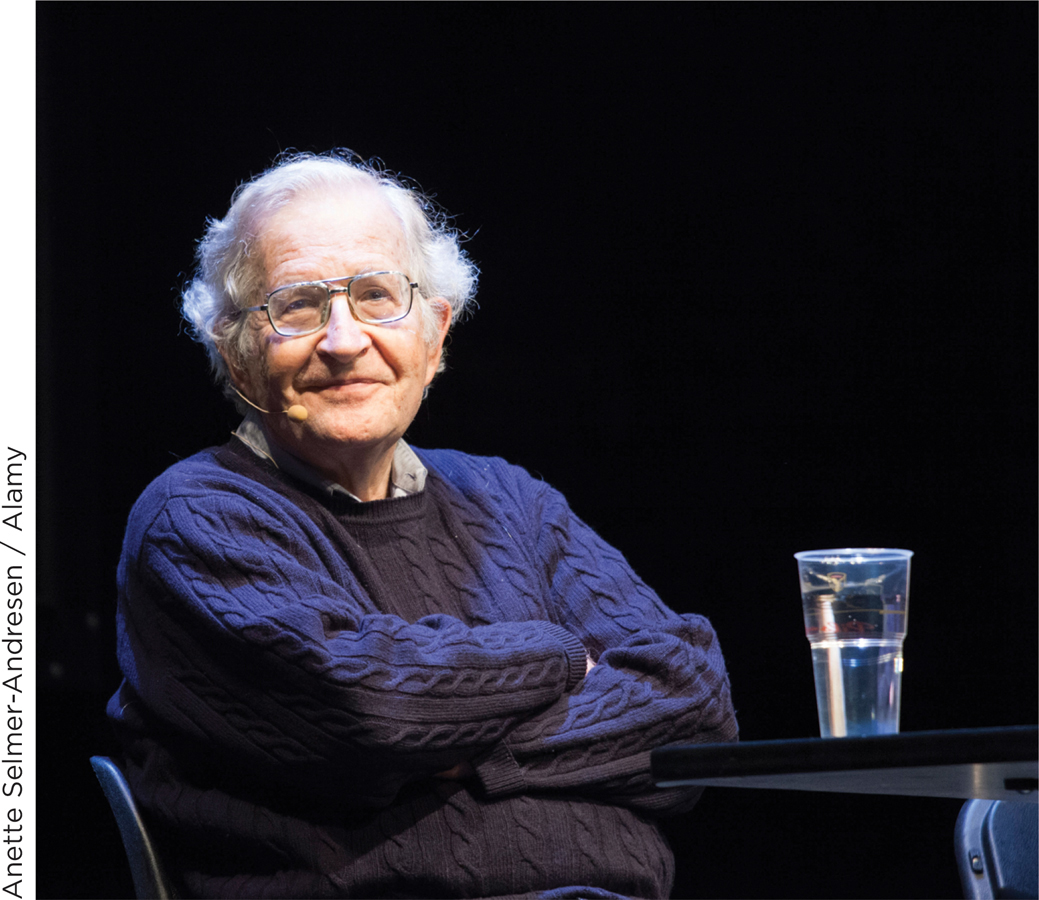
Language Acquisition
Preview Question
Question
 How do children acquire language?
How do children acquire language?
CONNECTING TO EVOLUTION AND TO PSYCHOLOGICAL DISORDERS
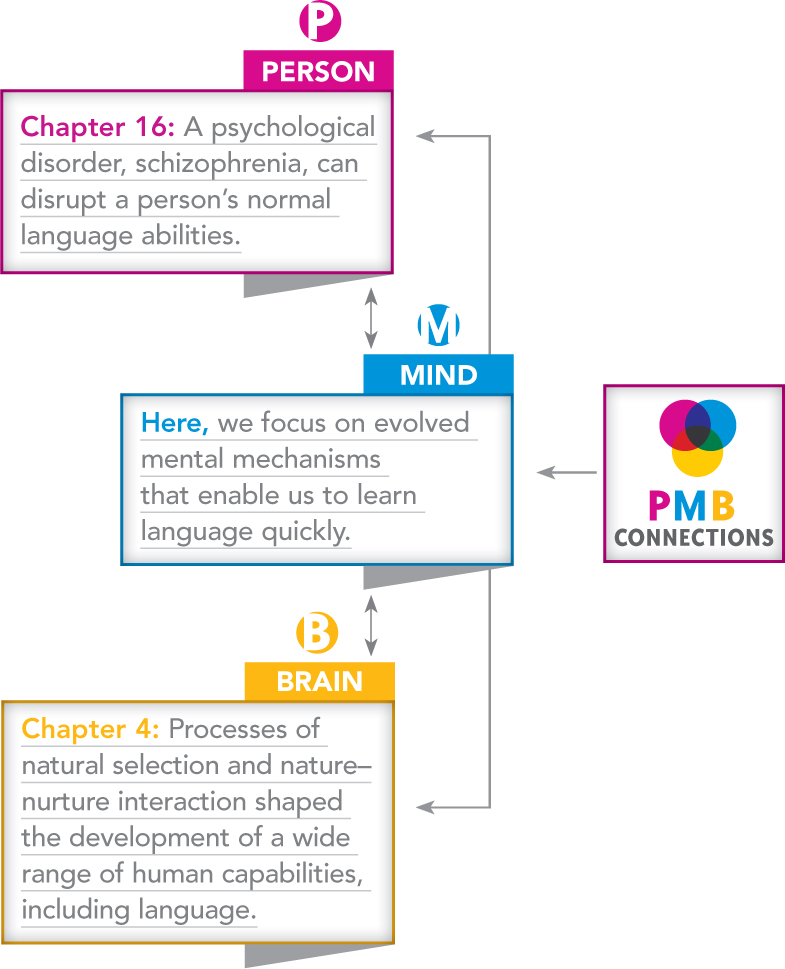
Everybody acquires language—
What do you find most difficult about learning another language?
REWARDS. The first theory is famous for being more wrong than right. The learning psychologist B. F. Skinner (1957; see Chapter 7) believed that children learn language by experiencing environmental rewards. If a child looks at a cookie and says, “Cookie,” the behavior is rewarded: Adults praise the child (and may give her the cookie). Because people tend to repeat behaviors that, in their experience, have been rewarded, rewards could drive language acquisition.
But there’s a problem with Skinner’s theory: It cannot explain how children learn grammar even when they are not rewarded for doing so (Chomsky, 1959)—and they usually are not. Parents rarely reward grammar use; “in general,” researchers find, “parents [seem] to pay no attention to bad syntax” (Brown, 1973, p. 412). They reward statements that are factually correct, even if grammatically flawed. Yet children learn grammar.
INNATE MECHANISMS. In a second type of theory, Chomsky (1965, 1980; Hauser et al., 2002) argued that language ability is innate. We don’t “learn” grammar any more than we “learn” breathing or digestion; each is done automatically by evolved biological mechanisms (see Chapter 4). Chomsky proposed, specifically, that people inherit a mental mechanism—
There, of course, is some role for learning as well—
According to Chomsky, humans’ inherited language mechanism contains a universal grammar, which is a set of rules that enable people to understand and produce sentences. It is “universal” in that all human beings possess the grammatical ability. Chomsky therefore predicts that all human languages will have common features, including sentences containing noun and verb phrases.
THINK ABOUT IT
Suppose you study a number of languages—
Chomsky’s proposal has been accepted widely, but not universally (see This Just In). In a third type of theory, learning plays a larger role than Chomsky envisioned, but the learning is more complex than the reward process Skinner proposed.
THIS JUST IN
Universal Grammar?
By the late twentieth century, Noam Chomsky’s claim that all people possess a universal grammar—
Evans and Levinson find variations in language grammars that are unpredicted by Chomsky. Some languages lack adverbs. Others lack adjectives. Still others appear to lack the distinction between noun and verb; for example, rather than having the verb “sing” and the noun “singers,” a language may have just one word that gets embedded into surrounding phrases such as “the ones who sing” (Evans & Levinson, 2009). Furthermore, some languages have word types not found in English, that is, types of words other than nouns, verbs, adjectives, adverbs, and prepositions.
The exact structure of the world’s languages is a question to be resolved by linguists, not psychologists. Yet these findings are a cautionary tale for psychology. Before looking into the mind or brain for the source of universal human tendencies, one has to be sure that they really are universal—
WHAT DO YOU KNOW?…
Question 7
Grammar may not be as as Chomsky believed. Some languages, for example, lack adjectives.
Do you enjoy word jumbles? If so, your success at them is due, in part, to statistical language learning.
STATISTICAL LANGUAGE LEARNING. The third approach to the study of language acquisition is called statistical language learning (Rebuschat & Williams, 2012; Romberg & Saffran, 2010). It proposes that children acquire language by learning patterns of sounds and words they hear frequently, in other words, that are statistically common. According to statistical learning theory, then, the key mental mechanism in language learning is a general ability to distinguish between frequent and rare events.
Here’s the type of question statistical language learning theory can answer. If you say “pretty baby” to a baby, how does the child know you said “pretty baby” and not “pri tee-
Statistical language learning represents “a new view of language acquisition” (Kuhl, 2000). Like Skinnner’s approach, it emphasizes the role of experience in learning language. But unlike Skinner, it identifies an inherent mental ability that infants possess that enables them to learn language: the ability to identify the frequency with which various speech sounds are heard. Statistical language learning differs strikingly from the approach of Chomsky. Unlike Chomsky, who proposed that knowledge of grammatical structure is innate (i.e., an inherited product of human evolution), statistical language learning theorists propose that grammar is learned through experience. This emphasis on experience suggests that, in language acquisition, culture plays a substantial role. To acquire a language, you have to coordinate your behavior with that of others in your culture (Chater & Christiansen, 2010). To communicate, you have to communicate like them.
The cases of Natasha in Siberia and of the twins in San Diego, from this chapter’s opening, can be addressed from either an innate or a statistical learning perspective. Chomsky would say that the twins, who developed their own language, provided each other with “triggering experiences” that turned on their innate language mechanisms. Statistical learning theorists would suggest that the twins learned to coordinate their communications with each other. Both perspectives would predict that the isolated Natasha would fail to develop human language. She lacked a triggering experience—
WHAT DO YOU KNOW?…
Question 8
According to one theory of language acquisition, language is a(n) , much like flying is to birds, and we rely on a universal to help us communicate. Running counter to this idea is statistical language learning, a theory suggesting that we acquire language by noticing which sounds and words are most statistically , a practice that requires us to coordinate our behavior with others of our .
CULTURAL OPPORTUNITIES
Adjectives, Verbs, and Patterns of Thought
People around the world communicate by linking noun phrases to verb phrases. Are there any significant cultural differences in how they do this?
Philosophers provide insight into this question. They note that language is a social activity; to communicate, you must coordinate your actions (speaking, writing) with those of others (Wittgenstein, 1953). Because different cultures have different social practices, language use may vary across cultures (Wierzbicka, 1999). Evidence of differences comes from a study conducted in one Western (Melbourne, Australia) and one Eastern (Seoul, South Korea) locale.
The study’s methods were simple (Kashima et al., 2006). Participants wrote descriptions of various topics—
The cultures differed enormously in word use (Figure 8.3). Australians used a lot of adjectives. When describing family life, for instance, about two-

What could create these cultural differences? One possibility is cultural variations in overall patterns of thinking (Nisbett et al., 2001). In Western cultures, people tend to think about inner properties of objects that endure across time and place. When Westerners say “is talkative,” they refer to an enduring inner trait of the family. In Eastern cultures, people tend to think about how people (or objects) relate to the environment in which they are located. State verbs capture these person–
When it comes to language use, then, culture makes a difference.
WHAT DO YOU KNOW?…
Question 9
Given the above discussion on cultural variations in patterns of thinking and language, determine which of the sentences below was likely written by someone from a Western culture and which was likely written by someone from an Eastern culture.
“My friend enjoys playing tennis with her family. Though she has doubts about her academic skills, she thinks it would be great if she could go to college nearby.”
“My friend is a great tennis player. She is not very confident about her academic skills, but has the goal of going to college nearby.”
a. Easterner, b. Westerner
Language and the Brain
Preview Questions
Question
 What did early discoveries in the study of language and the brain say about brain regions involved in producing and understanding language?
What did early discoveries in the study of language and the brain say about brain regions involved in producing and understanding language?
Question
 How has contemporary brain-
How has contemporary brain-
Let’s shift levels of analysis, from the mind to the brain. What parts of the brain are most involved in language use? We’ll look at some early discoveries in this field of study, and then at recent brain-
EARLY DISCOVERIES. In the nineteenth century, French physician Paul Broca had an unusual patient. A man named LeBorgne had, Broca explained, “all the freedom of his intelligence and his movements … but he cannot speak” (Schiller, 1979, p. 174). He could understand speech; when asked a question, he gestured in ways that revealed his understanding. But he could not put his thoughts into words. LeBorgne suffered from aphasia, an impairment of language abilities that occurs while other mental abilities remain intact.
When LeBorgne died in 1861, Broca performed an autopsy and examined his brain (Schiller, 1979). There was disease-

People with damage to Broca’s area may be able to produce some meaningful speech, but their verbal output, produced with difficulty, consists only of individual words rather than grammatical sentences. When asked to describe the weather in a sentence, a patient might say merely, “Weather … sunny” (Geschwind, 1970).
Later in the nineteenth century, a German physician and researcher, Carl Wernicke, observed patients who could not understand language (Geschwind, 1970). Their hearing was intact, but words made no sense to them. Like Broca, Wernicke examined his patients’ brains after their deaths. He found damage in an area different from the one identified by Broca: a region in the left temporal lobe, near the part of the brain that processes sound, which has come to be known as Wernicke’s area (Figure 8.5).

Because patients with damage in Wernicke’s area cannot understand language, they also cannot produce meaningful sentences. They are able to easily combine nouns and verbs according to rules of syntax, but their sentences are meaningless semantically. A patient might say, “I was over in the other one, and then after they had been in the department, I was in this one” (Geschwind, 1970, p. 941).
Think about how frustrating it is when you just don’t get what someone is saying. Do you think this even comes close to the experience of someone with damage to Wernicke’s area?
BRAIN-
However, brain damage is not the only relevant source of evidence. Another—
Areas beyond Broca’s and Wernicke’s areas contribute to language. Imaging studies reveal that a large number of interconnected brain regions, primarily in the frontal, temporal, and parietal lobes, contribute to people’s ability to produce language (Bookheimer, 2002).
Broca’s and Wernicke’s areas are involved in other mental activities in addition to language. Contemporary evidence shows that these brain regions are not language specific; that is, they are not involved only in language understanding and production (Fedorenko & Kanwisher, 2009). For example, “language regions” of the brain are active when people perceive colors (Siok et al., 2009). When participants had to distinguish among colors presented in their right visual field, and that thus were processed on the left side of the brain (see Chapter 3), neural regions active in language processing were also active in the color perception task.
Brains differ. The Broca/Wernecke conception assumed that everybody was basically the same. Just as all people use eyes to see and ears to hear, maybe everybody uses the same anatomical areas of the brain for language. fMRI evidence, however, reveals “high levels of anatomical variability” (Fedorenko & Kanwisher, 2009, p. 2). People can differ in the exact areas of the brain that are active during language use. For example, when researchers presented sentences about hockey to people who varied in their knowledge of the sport, their patterns of brain activation differed (Beilock et al., 2008). Among expert players and long-
time fans, an area of the brain involved in motor movement was also active during the processing of the sentences (Figure 8.6).
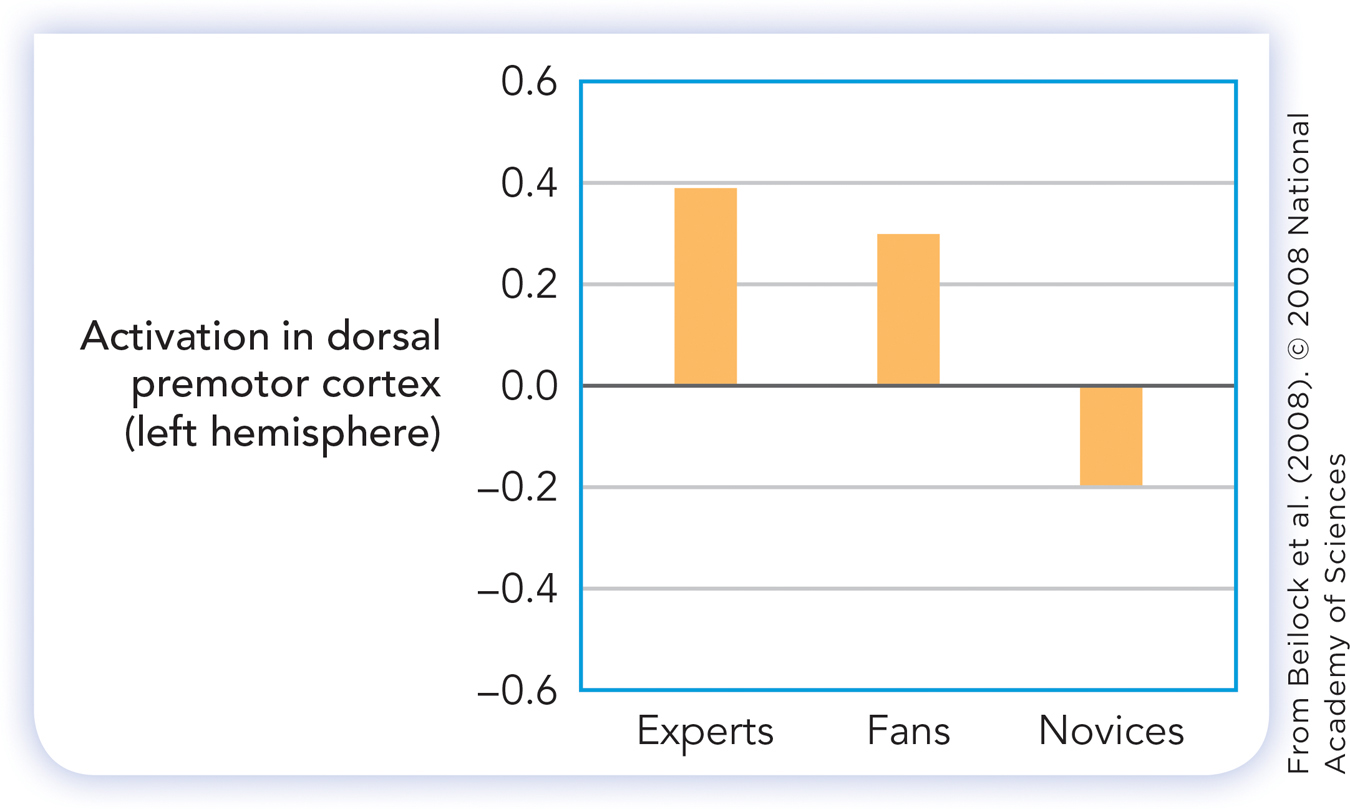
The original belief, that damage to Broca’s and Wernicke’s areas disrupts language, is correct. But the idea that these two brain regions are uniquely responsible for language is not. Broca’s area and Wernicke’s area are parts of the brain needed for normal language use, but they are not independently responsible for language.
WHAT DO YOU KNOW?…
Question 10
True or False?
Damage to Wernicke’s area would disrupt an individual’s ability to understand and produce language.
A. B. - Page 323
Damage to Broca’s area would only disrupt the ability to produce language.
A. B. Brain-
imaging studies indicate that Broca’s area and Wernicke’s area are the only areas that contribute to language processing. A. B. People differ from one another in patterns of brain activity during language use.
A. B.
Animals’ “Language”
Preview Question
Question
 Why don’t animals have language?
Why don’t animals have language?
So far, we’ve discussed communication among human beings. What about our furry friends?
Animals definitely can communicate. Bees, for example, make movements that signal the presence of food to other bees. But is this language? Recall that language is a system in which the language-
If you observe animals, it doesn’t look as if they are doing this. But maybe that’s because they haven’t been taught properly. The psychologist Herbert Terrace decided to find out what would happen if an animal received language training, as humans do (Hess, 2008).
Terrace raised a newly born chimpanzee, which he named Nim Chimpsky (after Noam Chomsky), in a human setting: a New York City apartment populated by humans. Terrace’s goal was to pit Chimpsky versus Chomsky. If Chimpsky learned language, he would disprove Chomsky’s contention that language stems from a uniquely human innate brain mechanism.
Terrace knew Chimpsky would never speak like a human; chimps lack the physical ability to produce human speech sounds. But they do have manual dexterity. Terrace therefore tried to teach Nim sign language. A sign language is a language in which bodily movements, especially of the hands and fingers, are used to convey information. Nim was tutored in sign language day after day, year after year.
What happened? After four years of instruction, Terrace concluded that Nim never developed true language use (Hess, 2008). He could imitate signs his teachers made. However, unlike a human child, Nim never generated novel combinations of signs to express ideas. Nim is not alone in the animal world; no animal has ever displayed true language use.
Human language abilities require a wide range of cognitive skills (Fitch, Hauser, & Chomsky, 2005; Pinker & Jackendoff, 2005), and Nim, and other animals, do possess some of them. For example, the skills of language acquisition include using symbols (words) to refer to objects in the world, remembering the meaning of the symbols, and combining them. Many animal species can perform some of these skills. A chimp named Washoe, for example, learned hand signals that symbolized “please” and “drink,” and combined them into “please drink” (Gardner & Gardner, 1969). An African Grey Parrot learned speech sounds that referred not only to objects, but also to categories of objects (Pepperberg, 1991).
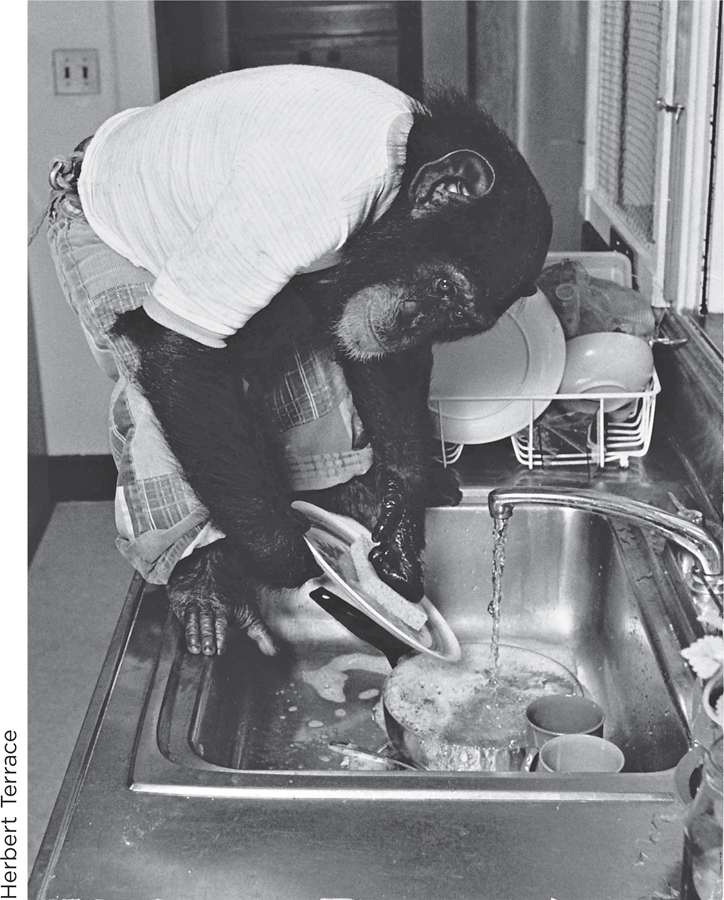
Remarkable as these animal abilities are, however, they are not the same as human language (Hauser et al., 2002). Animals fail to display language skills that are common among humans. For example, animals know which members in their pack are the dominant ones, but their vocalizations don’t reflect this knowledge. They signal others with sounds but, when doing so, don’t take into account the knowledge and goals of the animals to whom they’re communicating, as humans do. Most important, animal communication is not generative; animals do not use rules of syntax to generate an indefinite variety of sentences, as even young human children do. “Nearly a century of intensive research” shows that “no species other than humans has a comparable capacity to recombine meaningful units into an unlimited variety of larger structures” (Hauser et al., 2002, p. 1576).
WHAT DO YOU KNOW?…
Question 11
Although it’s true that chimps are capable of using symbols to refer to objects in the world and of combining those symbols, it is not true to say that they use language. Why?
How do your pets communicate with you, if not through language?
